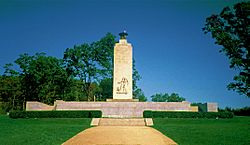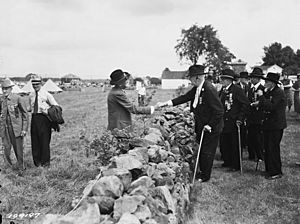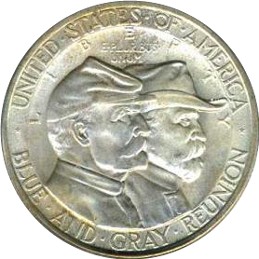1938 Gettysburg reunion facts for kids
Quick facts for kids 1938 Gettysburg reunion |
|
|---|---|
| Gettysburg College & Gettysburg National Military Park in United States |
|

North of the veterans' camp, the Eternal Light Peace Memorial was unveiled during the reunion.
|
|
| Coordinates | 39°50′22″N 77°14′12″W / 39.8395°N 77.2366°W |
| Site history | |
| In use | June 29-July 6 ceremonies & events: June 1–4 |

The 1938 Gettysburg reunion was a special gathering of American Civil War veterans. It took place on the Gettysburg Battlefield to mark the 75th anniversary of the Battle of Gettysburg. About 25 veterans who fought in the actual battle attended. In total, 1,359 Union (Federal) and 486 Confederate veterans were there. These veterans were, on average, 94 years old.
The United States government paid for their travel, housing, and food. If a veteran needed help, an attendant was also provided. President Franklin D. Roosevelt gave a speech on July 3rd. His speech was given just before the Eternal Light Peace Memorial was officially revealed. A video of part of his speech was even placed in the Westinghouse Time Capsule for the 1939 New York World's Fair.
Many people helped make the reunion happen. This included 19 officers and 250 soldiers from the Pennsylvania National Guard. In total, 3,185 United States Army personnel were present. There were also 548 police officers from Pennsylvania, New York City, Philadelphia, and Pittsburgh. A building at Gettysburg College served as the main hospital for the event.
Contents
Planning the Reunion
To help pay for the reunion, Congress allowed the US Mint to create 50,000 special commemorative half dollars in June 1936. This coin, called the Battle of Gettysburg half dollar, was dated 1936 but was actually made in 1937. A sculptor named Frank Vittor used a Union veteran as his model for the coin's design. There was also a push to create a special US postage stamp for the reunion's opening day. Any coins that were not sold were later destroyed.
Key Dates in Planning
- 1935: Pennsylvania created a group to plan the 75th anniversary of the battle.
- 1936: A bill was suggested in Congress to form a federal committee. This committee would work with Pennsylvania's planning group.
- 1937 January 25: A plan was made for a new memorial to be dedicated at the 1938 reunion. This memorial would be called the "Gettysburg Peace Memorial."
- 1937 May 8: The special Gettysburg commemorative half dollars went on sale for $1.65 each. They were sold at the Hotel Gettysburg and two local banks.
Events of 1938
- January 15: The Marine Corps Band was sent to perform at the reunion. Four other bands also played at the camp.
- February: The town of Gettysburg, Pennsylvania, formed its own committee for the reunion.
- April 18: The Works Progress Administration began making improvements to the Gettysburg National Military Park.
- April 26: Work started on building the veterans' camp. It was located near Gettysburg College. The Civilian Conservation Corps (CCC) helped build the camp and also served as guides for the veterans.
- May 16: President Franklin D. Roosevelt signed a bill. This bill provided $900,000 from the government for transportation and the camp.
- June 25: The 1st Medical Regiment arrived to provide medical care.
- June 29: Twelve special trains arrived, bringing the veterans to Gettysburg.
Reunion Days
The reunion included several important days with different activities:
- July 1, Friday (Reunion Day)
- The opening ceremonies were held in the Gettysburg College Stadium.
- The Secretary of War, Harry Hines Woodring, gave a speech.
- July 2, Saturday (Veterans' and Governors' Day)
- A long parade took place, lasting two and a half hours. It went through Lincoln Square.
- The parade included important visitors, US Army units, and over 50 drum and bugle corps.
- The United States Marine Band held a concert in the college stadium.
- July 3, Sunday (President's Day)
- A memorial service was held in the college stadium in the morning.
- Veterans from both sides shook hands over the stone wall at The Angle. This was a symbol of peace, just like at the 1913 Gettysburg reunion.
- About 250,000 people attended the dedication of the Eternal Light Peace Memorial. Many more were stuck in traffic.
- As President Roosevelt's speech ended at sunset, the Peace Memorial was unveiled. Two 91-year-old veterans, one Union and one Confederate, helped reveal it.
- Army aircraft performed a pretend air raid at dusk. Searchlights lit up the planes as they dropped flares.
- July 4, Monday (United States Army Day)
- The military showed off its equipment. This included 31 fast light tanks near the college.
- An air show featured 18 Northrop A-17As and several large B-17 Flying Fortress bombers.
- Fireworks were launched from Oak Hill.
Departure of Troops
After the main events, military units began to leave Gettysburg:
- July 5: The 62nd Coastal Artillery and the 12th Infantry departed. The Third Cavalry also left.
- July 6: The 66th Infantry and the 6th Field Artillery left.
- July 7: Most of the 34th Infantry departed.
- July 8: The last part of the 34th Infantry left. The 8th Quartermaster Regiment stayed until late July to take down the camp.
Legacy
- September 23: A World's Fair time capsule was buried. It included a 15-minute newsreel with part of President Roosevelt's Gettysburg reunion speech.
| State | # |
|---|---|
| California | 150 |
| Texas | 130 |
| Pennsylvania | 115 |
| Ohio | 103 |
| Georgia | 63 |
| Florida | 48 |
| Mississippi | 42 |
| North Carolina | 35 |
| 30 others, avg | 34 |
| Alabama | 32 |
| Tennessee | 31 |
| Maryland | 22 |
| South Carolina | 19 |
| Kentucky | 16 |
| Louisiana | 15 |
| Virginia | 14 |
| Arkansas | 9 |
| Nevada | 1 |
| Wyoming | 1 |
| Rhode Island | 0 |



